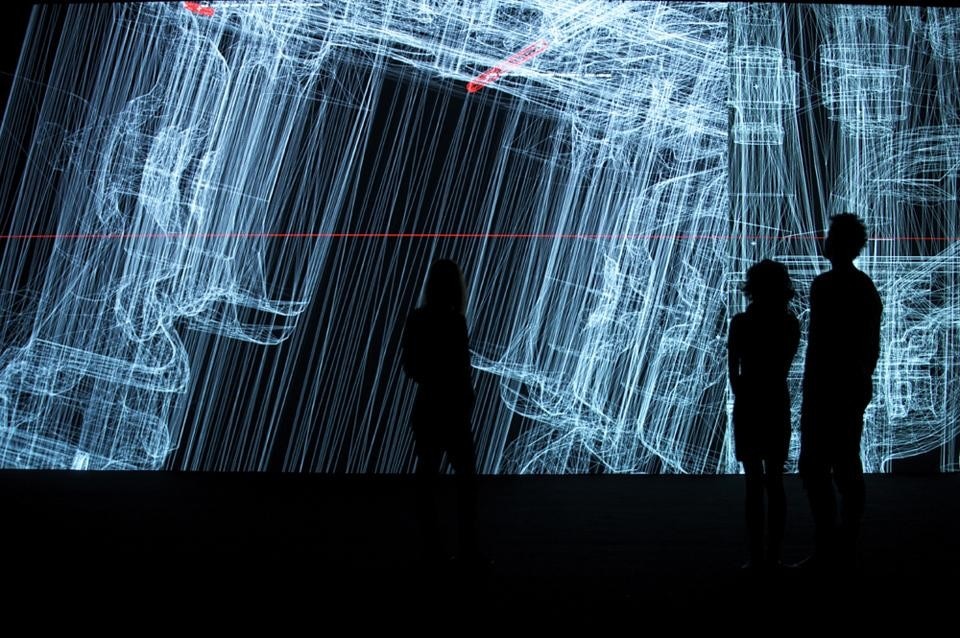Though Ikeda's latest installation in Berlin's MUMA (Kraftwerk) building might sound like little more than an inventive commercial for Honda, the artist has a back-catalogue of works which transform abstract masses of complex data into stunning audiovisual experiences, so this particular collaboration is much less far fetched than some other designer-brand teams of recent memory.
Of course, Ikeda typically works with vast sets of data from sources as varied as the solar system or the Human Genome Project, so it's interesting to see him working for the first time with data from a single specific object.
Is the experience lessened because the data set is taken from a Honda Civic and not the solar system? Yes and no. It's still the same impeccably high level of technical brilliance one expects from Ikeda — the visuals are clean and precise and the sound is as crisp as lettuce in an ice box and reverberates throughout the enormous old industrial space in a pleasingly buzzy fashion. But at only 12 minutes in length, data.anatomy [civic] is far less ambitious than his other installations I've seen. It also feels a bit too polite. In datamatics [ver 2.0], which I saw Ikeda perform live last year at the Barbican, there are tsunami-like waves of audio intensity that bombard the senses. It's an utterly joyous, transformative metaphysical experience; an experience which is somewhat lacking in data.anatomy [civic].
![Ryoji Ikeda, <em>data.anatomy [civic]</em> at the MUMA Kraftwerk Berlin, installation view Ryoji Ikeda, <em>data.anatomy [civic]</em> at the MUMA Kraftwerk Berlin, installation view](/content/dam/domusweb/en/art/2012/05/03/ryoji-ikeda-data-anatomy-civic-/big_381597_6005_web_dataanatomy_civic__image4.jpg.foto.rmedium.jpg)
![Ryoji Ikeda, <em>data.anatomy [civic]</em> at the MUMA Kraftwerk Berlin, installation view Ryoji Ikeda, <em>data.anatomy [civic]</em> at the MUMA Kraftwerk Berlin, installation view](/content/dam/domusweb/en/art/2012/05/03/ryoji-ikeda-data-anatomy-civic-/big_381597_4099_web_dataanatomy_civic__image12.jpg.foto.rmedium.jpg)
With much of Ikeda’s work, an effort is made to transform the code which underlies the everyday reality of life into something sublime, simply by enabling us to see and to hear, to understand the language of the data
![Ryoji Ikeda, <em>data.anatomy [civic]</em> at the MUMA Kraftwerk Berlin, installation view Ryoji Ikeda, <em>data.anatomy [civic]</em> at the MUMA Kraftwerk Berlin, installation view](/content/dam/domusweb/en/art/2012/05/03/ryoji-ikeda-data-anatomy-civic-/big_381597_7676_web_dataanatomy_civic__image8.jpg.foto.rmedium.jpg)
![Ryoji Ikeda, <em>data.anatomy [civic]</em> at the MUMA Kraftwerk Berlin, installation view Ryoji Ikeda, <em>data.anatomy [civic]</em> at the MUMA Kraftwerk Berlin, installation view](/content/dam/domusweb/en/art/2012/05/03/ryoji-ikeda-data-anatomy-civic-/big_381597_3573_web_dataanatomy_civic__image7.jpg.foto.rmedium.jpg)
![Ryoji Ikeda, <em>data.anatomy [civic]</em> at the MUMA Kraftwerk Berlin, installation view Ryoji Ikeda, <em>data.anatomy [civic]</em> at the MUMA Kraftwerk Berlin, installation view](/content/dam/domusweb/en/art/2012/05/03/ryoji-ikeda-data-anatomy-civic-/big_381597_6381_web_dataanatomy_civic__image6.jpg.foto.rmedium.jpg)
![Ryoji Ikeda, <em>data.anatomy [civic]</em> at the MUMA Kraftwerk Berlin, installation view Ryoji Ikeda, <em>data.anatomy [civic]</em> at the MUMA Kraftwerk Berlin, installation view](/content/dam/domusweb/en/art/2012/05/03/ryoji-ikeda-data-anatomy-civic-/big_381597_2173_web_dataanatomy_civic__image10.jpg.foto.rmedium.jpg)


